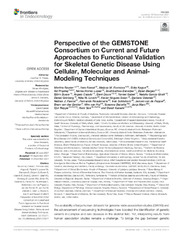Приказ основних података о документу
Perspective of the GEMSTONE Consortium on Current and Future Approaches to Functional Validation for Skeletal Genetic Disease Using Cellular, Molecular and Animal-Modeling Techniques
| dc.creator | Rauner, Martina | |
| dc.creator | Foessl, Ines | |
| dc.creator | Formosa, Melissa | |
| dc.creator | Kague, Erika | |
| dc.creator | Prijatelj, Vid | |
| dc.creator | Alonso Lopez, Nerea | |
| dc.creator | Banerjee, Bodhisattwa | |
| dc.creator | Bergen, Dylan | |
| dc.creator | Busse, Björn | |
| dc.creator | Calado, Angelo | |
| dc.creator | Douni, Eleni | |
| dc.creator | Gabet, Yankel | |
| dc.creator | Garcı´a Giralt, Natalia | |
| dc.creator | Grinberg, Daniel | |
| dc.creator | Lovsin, Nika | |
| dc.creator | Nogues Solan, Xavier | |
| dc.creator | Ostanek, Barbara | |
| dc.creator | Pavlos, Nathan | |
| dc.creator | Rivadeneira, Fernando | |
| dc.creator | Soldatović, Ivan | |
| dc.creator | van de Peppel, Jeroen | |
| dc.creator | van der Eerden, Bram | |
| dc.creator | van Hul, Wim | |
| dc.creator | Balcells, Susanna | |
| dc.creator | Marc, Janja | |
| dc.creator | Reppe, Sjur | |
| dc.creator | Søe, Kent | |
| dc.creator | Karasik, David | |
| dc.date.accessioned | 2022-01-10T12:34:01Z | |
| dc.date.available | 2022-01-10T12:34:01Z | |
| dc.date.issued | 2021 | |
| dc.identifier.issn | 1664-2392 | |
| dc.identifier.uri | https://farfar.pharmacy.bg.ac.rs/handle/123456789/4019 | |
| dc.description.abstract | The availability of large human datasets for genome-wide association studies (GWAS) and the advancement of sequencing technologies have boosted the identification of genetic variants in complex and rare diseases in the skeletal field. Yet, interpreting results from human association studies remains a challenge. To bridge the gap between genetic association and causality, a systematic functional investigation is necessary. Multiple unknowns exist for putative causal genes, including cellular localization of the molecular function. Intermediate traits (“endophenotypes”), e.g. molecular quantitative trait loci (molQTLs), are needed to identify mechanisms of underlying associations. Furthermore, index variants often reside in non-coding regions of the genome, therefore challenging for interpretation. Knowledge of non-coding variance (e.g. ncRNAs), repetitive sequences, and regulatory interactions between enhancers and their target genes is central for understanding causal genes in skeletal conditions. Animal models with deep skeletal phenotyping and cell culture models have already facilitated fine mapping of some association signals, elucidated gene mechanisms, and revealed disease-relevant biology. However, to accelerate research towards bridging the current gap between association and causality in skeletal diseases, alternative in vivo platforms need to be used and developed in parallel with the current -omics and traditional in vivo resources. Therefore, we argue that as a field we need to establish resource-sharing standards to collectively address complex research questions. These standards will promote data integration from various -omics technologies and functional dissection of human complex traits. In this mission statement, we review the current available resources and as a group propose a consensus to facilitate resource sharing using existing and future resources. Such coordination efforts will maximize the acquisition of knowledge from different approaches and thus reduce redundancy and duplication of resources. These measures will help to understand the pathogenesis of osteoporosis and other skeletal diseases towards defining new and more efficient therapeutic targets. | |
| dc.publisher | Frontiers Media S.A. | |
| dc.rights | openAccess | |
| dc.rights.uri | https://creativecommons.org/licenses/by/4.0/ | |
| dc.source | Frontiers in Endocrinology | |
| dc.subject | animal models | |
| dc.subject | data integration analysis | |
| dc.subject | gene regulation | |
| dc.subject | genome-wide association study | |
| dc.subject | musculoskeletal disease | |
| dc.title | Perspective of the GEMSTONE Consortium on Current and Future Approaches to Functional Validation for Skeletal Genetic Disease Using Cellular, Molecular and Animal-Modeling Techniques | |
| dc.type | article | |
| dc.rights.license | BY | |
| dc.citation.volume | 12 | |
| dc.citation.rank | M21 | |
| dc.identifier.wos | 000731742100001 | |
| dc.identifier.doi | 10.3389/fendo.2021.731217 | |
| dc.identifier.scopus | 2-s2.0-85121622954 | |
| dc.identifier.fulltext | http://farfar.pharmacy.bg.ac.rs/bitstream/id/9367/Perspective_of_the_pub_2021.pdf | |
| dc.type.version | publishedVersion |

